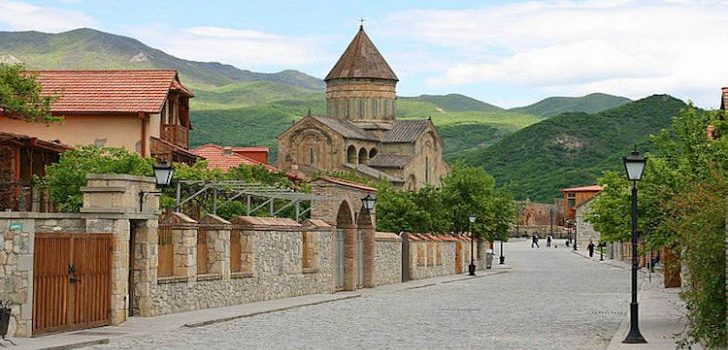Heritage Sites
Heritage Site
Cave Towns Among the few notable cave towns in the world, the Georgian ones are of very special interest. Uplistsikhe, David Gareji monastery, and the world-famous cave town of Vardzia are nominated for the UNESCO World Heritage list. Uplistsikhe, ‘the fortress of the Lord’, can be dated back to the early Iron Age, and is located on a high rocky escarpment overlooking the bank of the Mtkvari River. Cut from natural sandy stone, the 8 hectares of cave-town have survived millions of people, erosion, aging and even earthquakes, but it still remains a good example of the mixture of pagan & Christian architecture. David Gareji monastery was founded in the 6th century on the slopes of the Gareji hills by one of the thirteen Syrian Fathers, Father David (Garejeli). Those fathers were missionaries from Mesopotamia promoting and spreading Christianity, the respected founders of many monasteries and holy places around Georgia. The frescoes here are superb. Some of them date as far back as the 9th and 10th centuries. The Golden Age of Georgia is directly reflected in the incredible 11th – 13th century frescoes. The incredible cave town of Vardzia dates back to Queen Tamar’s reign, nearly a thousand years ago. Her father, King George III started the foundation of the complex, while Queen Tamar continued its construction. Many frescoes date back to the beginning of the XII century. The complex itself consists of small chapels, bell towers, secret tunnels, monks’ caves as well as a fully functioning monastery to this day. Set in the most serene and stunning countryside, its beautiful location captures your imagination and brings you back to the era of Queen Tamar’s reign. Bagrati Cathedral and Gelati Monastery(UNESCO WEB) The construction of Bagrati Cathedral, named after Bagrat III, the first king of united Georgia, started at the end of the 10th century and was completed in the early years of the 11th century. Although partly destroyed by the Turks in 1691, its ruins still lie in the centre of Kutaisi. The Gelati Monastery, whose main buildings were erected between the 12th and 17th centuries, is a well-preserved complex, with wonderful mosaics and wall paintings. The cathedral and monastery represent the flowering of medieval architecture in Georgia. Historical Monuments of Mtskheta(UNESCO WEB) The historic churches of Mtskheta, former capital of Georgia, are outstanding examples of medieval religious architecture in the Caucasus. They show the high artistic and cultural level attained by this ancient kingdom. Upper Svaneti(UNESCO WEB) Preserved by its long isolation, the Upper Svaneti region of the Caucasus is an exceptional example of mountain scenery with medieval-type villages and tower-houses. The village of Chazhashi still has more than 200 of these very unusual houses, which were used both as dwellings and as defence posts against the invaders who plagued the region.
Vardzia: ‘The Cave Town’
It is called the cave town.
Vardzia is a spectacular site in southern Georgia, dug out of the Erusheti Mountain in 1185.
It had special significance for Georgians because it was associated with King Tamar – such a charismatic woman that she was crowned King instead of Queen!
“Among all the architectural jewels of Georgia, the Vardzia complex is the most precious,” said ‘Postcards’ reporter Claudio Rosmino.
“In this city, carved into the rock, there were houses, shops, libraries and even a water network. In total, 6,000 rooms, spread out over 13 levels”
In 1283, just a century after its construction, a devastating earthquake destroyed a huge part of the site. What we see today is less than a third of its original size.
“Vardzia cave complex was built for approximately 48 years by hand and was designed to host 50,000 people for defence purposes,” explained museum guide Tina Zedginidze.
“But later it became a Royal monastery with educational functions”
A small group of monks is still living there. Some 300 apartments can be visited and in some tunnels the old irrigation pipes still bring drinkable water.
Source: Euronews.com


